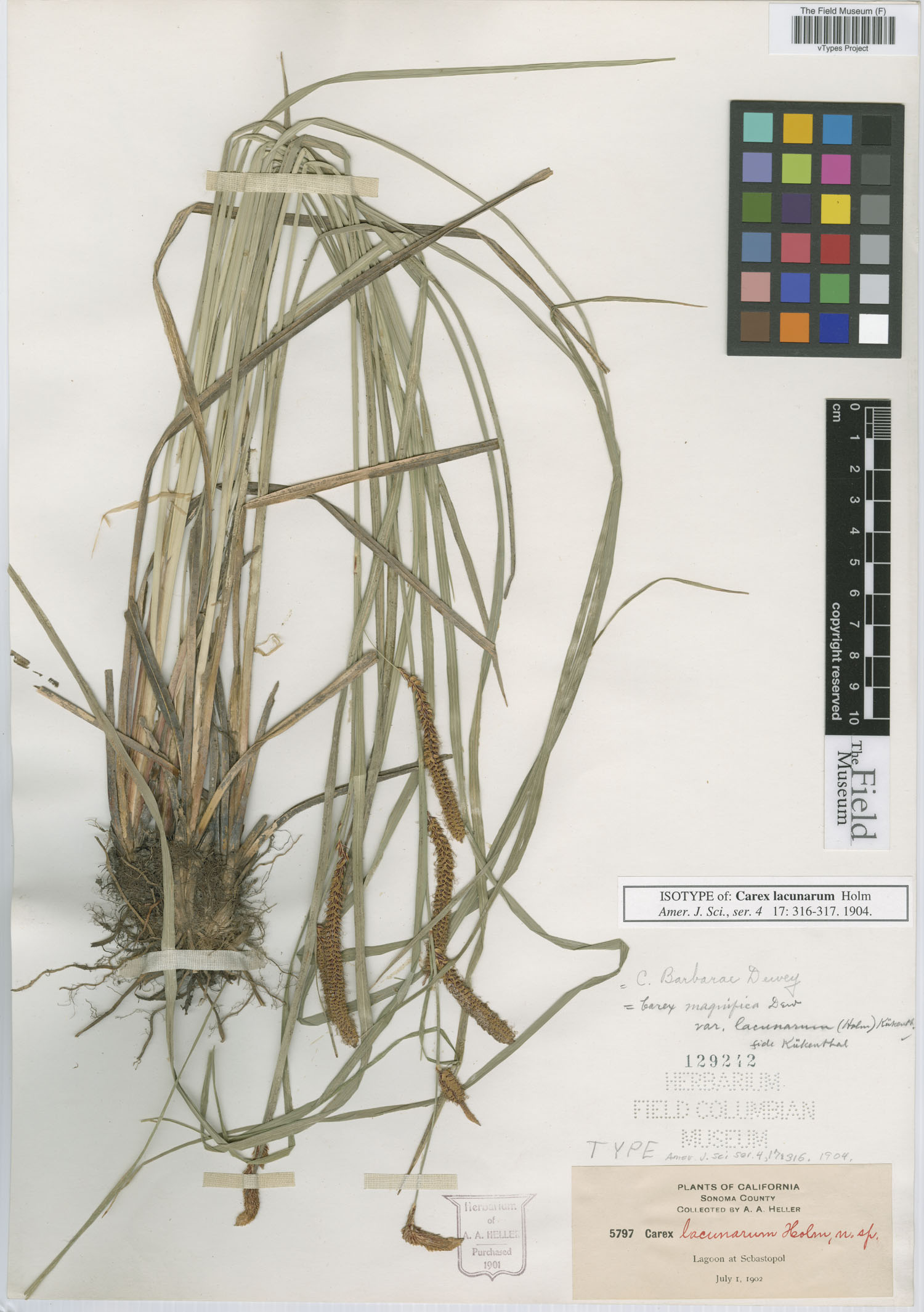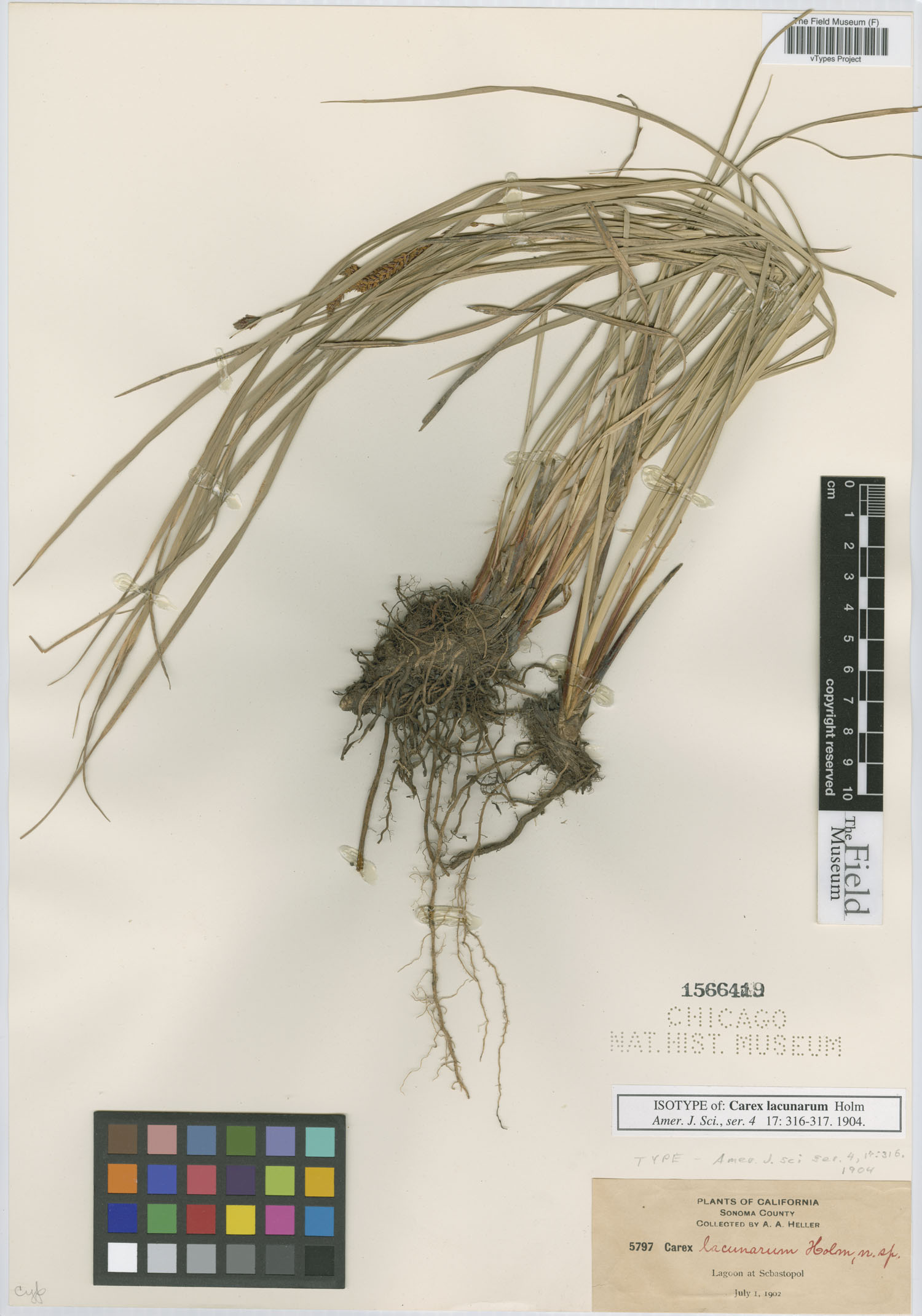Cyperaceae taxon details
Carex barbarae Dewey
1678117 (urn:lsid:marinespecies.org:taxname:1678117)
accepted
Species
Carex laciniata Boott · unaccepted
Carex lacunarum Holm · unaccepted
Carex magnifica var. lacunarum (Holm) Kük. · unaccepted
terrestrial
Emory, W. H. (1859). Report on the United States and Mexican Boundary Survey, Made Under the Direction of the Secretary of the Interior. 2(1)., available online at https://www.biodiversitylibrary.org/page/28872815#page/232/mode/1up
page(s): 231 [details]
page(s): 231 [details]
Description Plants not cespitose. Culms obtusely angled, 30–110 cm, glabrous. Leaves: basal sheaths brown; sheaths of proximal leaves...
Taxonomic remark Source in seed data: wcs Updated Author from Dewey to Dewey ex Torr., according to IPNI. Information provided by Alan E. on...
Description Plants not cespitose. Culms obtusely angled, 30–110 cm, glabrous. Leaves: basal sheaths brown; sheaths of proximal leaves scabrous, fronts with red-brown spots or uniformly red-brown, prominently ladder-fibrillose, apex U-shaped, red-brown; blades hypostomic, 4–9 mm wide, coriaceous, papillose abaxially. Inflorescences: proximal bract longer than inflorescence, 3–8 mm wide. Spikes erect, the proximal pendent, sessile or pedunculate; staminate 2–3; pistillate 4–6; the proximal pistillate spike 3–10 cm × 5–6 mm, base attenuate. Pistillate scales red-brown, longer than perigynia, apex acute, scabrous, awned, awn to 2 mm. Perigynia divergent, dark pale brown with red-brown spots on apical 1/2, faintly 3–5-veined on each face, somewhat inflated, loosely enclosing achenes, ellipsoid or obovoid, 3–4 × 2.2–2.5 mm, leathery, dull, apex rounded or obtuse, glabrous; beak red-brown, 0.5 mm, bidentate, orifice scabrous. Achenes not constricted, dull. [details]
Taxonomic remark Source in seed data: wcs Updated Author from Dewey to Dewey ex Torr., according to IPNI. Information provided by Alan E. on...
Taxonomic remark Source in seed data: wcs Updated Author from Dewey to Dewey ex Torr., according to IPNI. Information provided by Alan E. on email Jul. 15 2020. More details could be found in The Plant List v. [details]
Cyperaceae Working Group. (2025). [see How to cite]. Global Cyperaceae Database. Carex barbarae Dewey. Accessed at: https://www.cyperaceae.org/aphia.php?p=taxdetails&id=1678117 on 2025-09-11
Date
action
by
2024-12-10 11:47:54Z
unchecked
db_admin
![]() The webpage text is licensed under a Creative Commons
Attribution 4.0 License
The webpage text is licensed under a Creative Commons
Attribution 4.0 License
Nomenclature
original description
Emory, W. H. (1859). Report on the United States and Mexican Boundary Survey, Made Under the Direction of the Secretary of the Interior. 2(1)., available online at https://www.biodiversitylibrary.org/page/28872815#page/232/mode/1up
page(s): 231 [details]
original description (of Carex lacunarum Holm) Holm, T. (1904). Studies in the Cyperaceae. XXI. New or little known species of Carex. <em>American Journal of Science.</em> s4-17(100): 301-317., available online at https://doi.org/10.2475/ajs.s4-17.100.301
page(s): 316 [details]
basis of record Plants of the World Online (POWO). , available online at https://powo.science.kew.org/ [details]
page(s): 231 [details]
original description (of Carex lacunarum Holm) Holm, T. (1904). Studies in the Cyperaceae. XXI. New or little known species of Carex. <em>American Journal of Science.</em> s4-17(100): 301-317., available online at https://doi.org/10.2475/ajs.s4-17.100.301
page(s): 316 [details]
basis of record Plants of the World Online (POWO). , available online at https://powo.science.kew.org/ [details]
 Present
Present  Inaccurate
Inaccurate  Introduced: alien
Introduced: alien  Containing type locality
Containing type locality
Isotype (of Carex lacunarum Holm) F 0045407, geounit California [details]
Isotype GH 00027522, geounit United States [details]
Syntype (of Carex lacunarum Holm) US 00642108, geounit California [details]
From editor or global species database
Description Plants not cespitose. Culms obtusely angled, 30–110 cm, glabrous. Leaves: basal sheaths brown; sheaths of proximal leaves scabrous, fronts with red-brown spots or uniformly red-brown, prominently ladder-fibrillose, apex U-shaped, red-brown; blades hypostomic, 4–9 mm wide, coriaceous, papillose abaxially. Inflorescences: proximal bract longer than inflorescence, 3–8 mm wide. Spikes erect, the proximal pendent, sessile or pedunculate; staminate 2–3; pistillate 4–6; the proximal pistillate spike 3–10 cm × 5–6 mm, base attenuate. Pistillate scales red-brown, longer than perigynia, apex acute, scabrous, awned, awn to 2 mm. Perigynia divergent, dark pale brown with red-brown spots on apical 1/2, faintly 3–5-veined on each face, somewhat inflated, loosely enclosing achenes, ellipsoid or obovoid, 3–4 × 2.2–2.5 mm, leathery, dull, apex rounded or obtuse, glabrous; beak red-brown, 0.5 mm, bidentate, orifice scabrous. Achenes not constricted, dull. [details]Taxonomic remark Source in seed data: wcs Updated Author from Dewey to Dewey ex Torr., according to IPNI. Information provided by Alan E. on email Jul. 15 2020. More details could be found in The Plant List v. [details]
To Biodiversity Heritage Library (30 publications)
To Biodiversity Heritage Library (33 publications) (from synonym Carex laciniata Boott)
To Biodiversity Heritage Library (6 publications) (from synonym Carex lacunarum Holm)
To European Nucleotide Archive, ENA (Carex barbarae)
To Field Museum Herbarium (Carex lacunarum Holm F129242 isotype 1) (from synonym Carex lacunarum Holm)
To Field Museum Herbarium (Carex lacunarum Holm F1566419 isotype 1) (from synonym Carex lacunarum Holm)
To International Plant Names Index (IPNI) (from synonym Carex magnifica var. lacunarum (Holm) Kük.)
To International Plant Names Index (IPNI) (from synonym Carex lacunarum Holm)
To International Plant Names Index (IPNI) (from synonym Carex laciniata Boott)
To International Plant Names Index (IPNI)
To New York Botanical Garden Steere Herbarium (Carex_barbarae_NY688234_type_1)
To New York Botanical Garden Steere Herbarium (Carex_laciniata_NY11187_type_1) (from synonym Carex laciniata Boott)
To New York Botanical Garden Steere Herbarium (Carex_lacunarum_NY11188_type_1) (from synonym Carex lacunarum Holm)
To Plants of the World Online (from synonym Carex magnifica var. lacunarum (Holm) Kük.)
To Plants of the World Online (from synonym Carex lacunarum Holm)
To Plants of the World Online (from synonym Carex laciniata Boott)
To Plants of the World Online
To US Herbarium (Carex lacunarum US3412380 type 1) (from synonym Carex lacunarum Holm)
To US Herbarium (Carex lacunarum US430229 type 1) (from synonym Carex lacunarum Holm)
To Biodiversity Heritage Library (33 publications) (from synonym Carex laciniata Boott)
To Biodiversity Heritage Library (6 publications) (from synonym Carex lacunarum Holm)
To European Nucleotide Archive, ENA (Carex barbarae)
To Field Museum Herbarium (Carex lacunarum Holm F129242 isotype 1) (from synonym Carex lacunarum Holm)
To Field Museum Herbarium (Carex lacunarum Holm F1566419 isotype 1) (from synonym Carex lacunarum Holm)
To International Plant Names Index (IPNI) (from synonym Carex magnifica var. lacunarum (Holm) Kük.)
To International Plant Names Index (IPNI) (from synonym Carex lacunarum Holm)
To International Plant Names Index (IPNI) (from synonym Carex laciniata Boott)
To International Plant Names Index (IPNI)
To New York Botanical Garden Steere Herbarium (Carex_barbarae_NY688234_type_1)
To New York Botanical Garden Steere Herbarium (Carex_laciniata_NY11187_type_1) (from synonym Carex laciniata Boott)
To New York Botanical Garden Steere Herbarium (Carex_lacunarum_NY11188_type_1) (from synonym Carex lacunarum Holm)
To Plants of the World Online (from synonym Carex magnifica var. lacunarum (Holm) Kük.)
To Plants of the World Online (from synonym Carex lacunarum Holm)
To Plants of the World Online (from synonym Carex laciniata Boott)
To Plants of the World Online
To US Herbarium (Carex lacunarum US3412380 type 1) (from synonym Carex lacunarum Holm)
To US Herbarium (Carex lacunarum US430229 type 1) (from synonym Carex lacunarum Holm)









